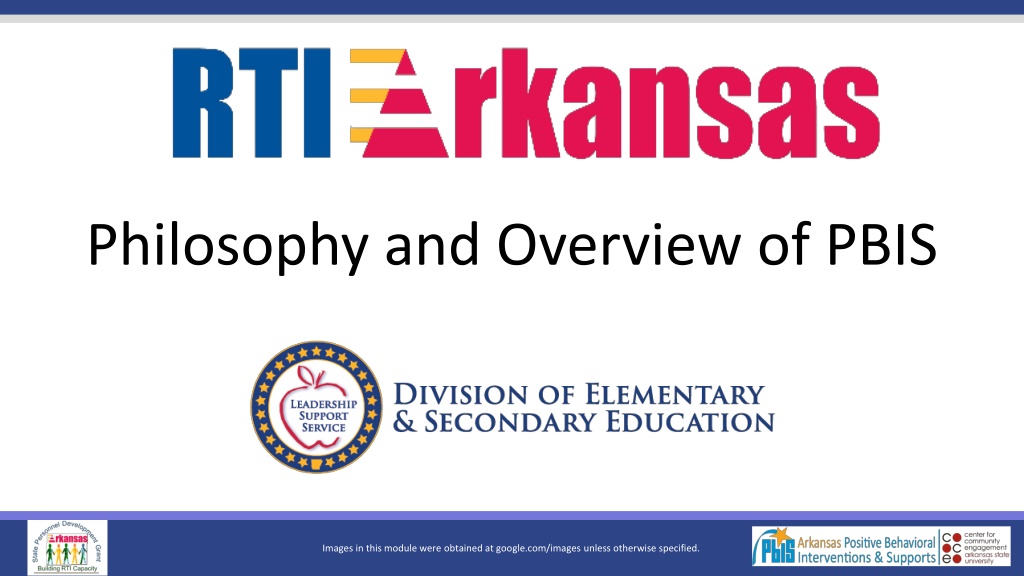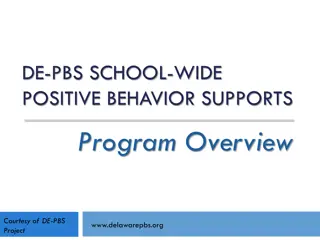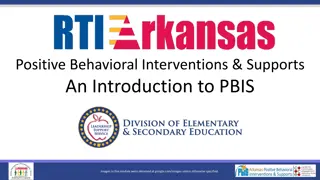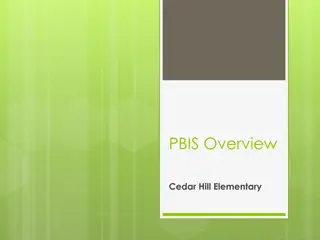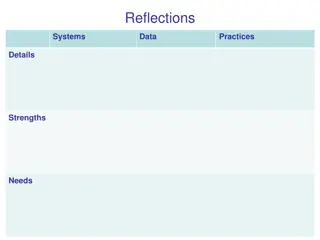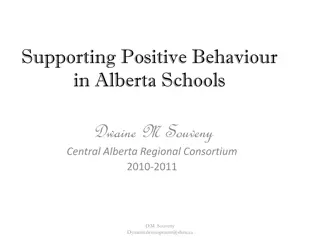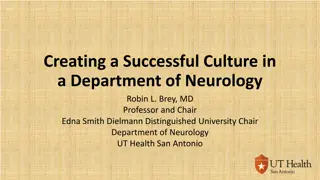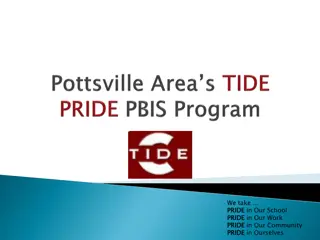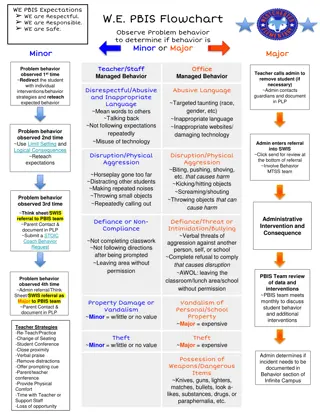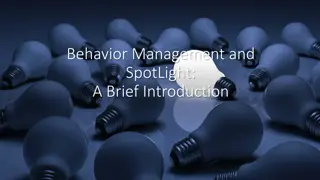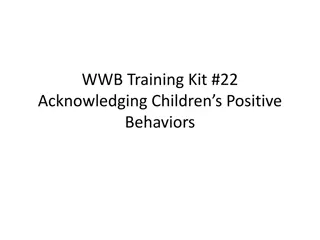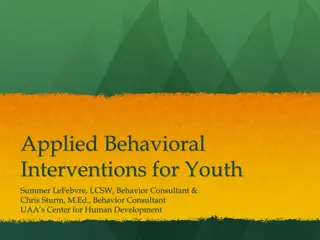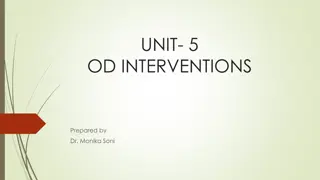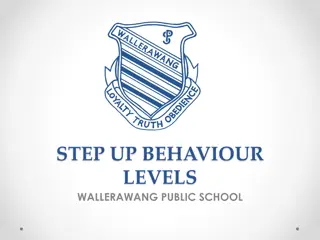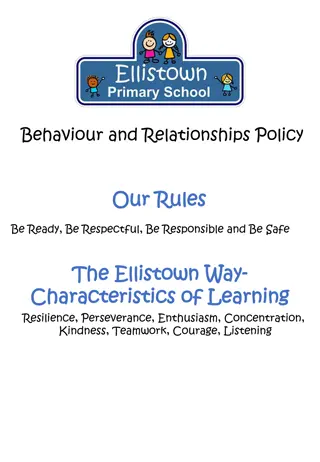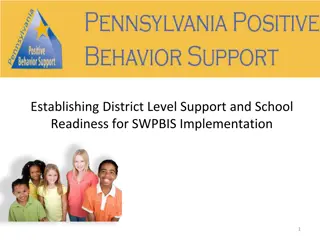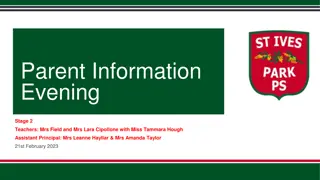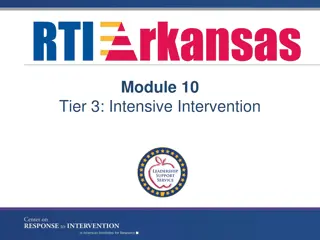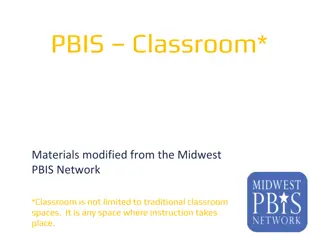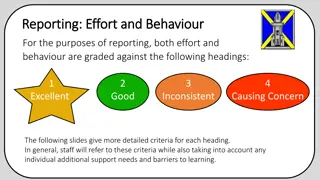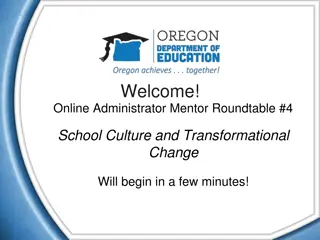Transforming School Culture Through Positive Behavior Interventions and Supports
Explore the philosophy, challenges, and solutions in implementing Positive Behavior Interventions and Supports (PBIS) in schools. Discover the importance of changing school culture, addressing student behaviors effectively, and creating a supportive learning environment. Learn how PBIS can enhance social and emotional development, improve academic performance, and foster positive relationships within the school community.
Download Presentation

Please find below an Image/Link to download the presentation.
The content on the website is provided AS IS for your information and personal use only. It may not be sold, licensed, or shared on other websites without obtaining consent from the author. Download presentation by click this link. If you encounter any issues during the download, it is possible that the publisher has removed the file from their server.
E N D
Presentation Transcript
Philosophy and Overview of PBIS Images in this module were obtained at google.com/images unless otherwise specified.
Context Philosophy of PBIS Steps in starting PBIS Before you begin PBIS trainings
Challenges For Schools Student mobility Perceived incivility Inappropriate behavior Student failure & dropouts Changes at home & in family Ever-increasing accountability
What Some Teachers Say Students don t really have any consequences. They do whatever they want. Teachers feel helpless. Teachers are made to feel small and disrespectful. Children need IMMEDIATE consequences They get more out of control every day. [We need to] revert back to real discipline and send them home!! Teacher survey responses, 2018
What Should A School Do? Should it increase in-school and out-of-school suspensions? Is the goal to get rid of children, even temporarily? What does that do to their learning? What does that do for their behavior? Should it increase expulsion? How many can you expel? How does that foster their achievement?
What Hasnt Worked? Zero tolerance policies & exclusion often lead to worse behavior. result in loss of learning time. don t help the student. reward student with vacation. How many things have schools tried?
So Now What? You Should Change The School Culture!
Basic School Climate Model Support for Learning Social and Civil Learning Rules and Norms Physical Safety Social and Emotional Security Teaching & Learning Safety Institutional Environment Interpersonal Relationships Respect for Diversity Social Support - Students Social Support - Adults Physical Surroundings School Connectedness/Engagement
Changing Climate And Culture Require A Different Philosophy How about preventing problems before they happen? How about a proactive and positive approach to discipline? Remember what discipline is about
What Is Discipline? Dis ci pline: From Latin disciplina( instruction ) and discipulus( pupil ), from discere( to learn )* It is a branch of knowledge or learning.** It is training that develops self-control, character, or orderliness and efficiency.** *http://www.yourdictionary.com **Webster's New World College Dictionary, Fifth Edition
Think About This If a child doesn t know how to read, we teach. If a child doesn t know how to swim, we teach. If a child doesn t know how to multiply, we teach. If a child doesn t know how to drive, we teach. If a child doesn t know how to behave, we teach? punish? Why can t we finish the last sentence as automatically as we do the others? Tom Herner (1998)
The PBIS Philosophy Adults must stop trying to get tougher; it will just anger and alienate children and leads to frustration. being reactive; it just keeps you angry because it doesn t work. assuming children all know how to behave . Adults must start acknowledging children when they do well (just like grades in academics). preventing problems by planning and being proactive. teaching children what you want them to do.
Really? Will That Work? Don t you like being acknowledged when you do good ? What is it when you say thank you ? Why do hotels, airlines, credit cards, etc. give reward points ? Students want respect just like you do, and they respond to it. Consequences are not ignored, but teaching comes first.
The PBIS Approach What is the approach? Using a multi-tiered system of support model Developing consistency in defining, teaching, modeling, and encouraging expected appropriate behavior Developing consistency in responding to problem behavior Using data to guide implementation and progress
A Continuum Of Practices: 3 Levels Of Prevention Tier III: Individualized supports for a few students. Tier II: Targeted supports for small groups of students. Tier 1: Core instruction for all students.
Levels, Or Tiers, Of Interventions PBIS is for ALL students (even those needing Tier 3 services). EVERYONE receives instruction in behavior. Some students may need more (Tiers 2 and 3), but they still get Tier 1 instruction and support.
Desired Outcomes: Social Competence Academic Achievement PBIS Model Outcomes Supporting Staff Behavior How will you support staff so they can support students? Supporting Data-based Decision Making How will you know if things are working? Data Systems Practices Supporting Student Behavior What practices will support students?
Tier I Components Developing behavioral expectations Teaching expected behaviors Acknowledging appropriate behavior Consistent responses to inappropriate behavior Data-based decision making Assessment Classroom PBIS
Outcomes Step 1 is to decide on what outcomes you want to see. What are your priority areas? If behavior isn t one, don t continue. What are your behavior goals? Use your school and district data to see what is needed. Example: 25% reduction in out of school suspensions.
Systems Step 2 in PBIS is to establish a team. The team is the basis for a PBIS system to facilitate implementation. Team needs to represent school (e.g., teachers, staff) Team needs a coach (positive, active coordinator) The school also needs a data system to collect and collate behavioral information. Team needs a data person Team needs to present data to stakeholders
Practices Step 3 is to identify expectations for student behavior. Expectations must be positively stated (e.g., respect), not a listing of violations. Expectations must encompass what the data say need changed in your school(s). Expectations need to be defined by specific behaviors. Expectations need to be defined for specific areas of school (e.g., cafeteria, hallway). Lesson plans need to be developed to teach the expectations in context.
Practices Contd Step 4 is to make PBIS part of the culture. An acknowledgement process for students needs to be developed. Responses to inappropriate behavior need to be examined and made consistent. An acknowledgement process for TEACHERS needs to be developed. Roll-out and boosters for behavior need to be developed. Data distribution practices to stakeholders are needed. Plans to identify successes and revisit needs have to be developed.
Tiers 2 And 3 Where do Tiers 2 and 3 fit? PBIS is about prevention first and foremost. Tier 1 must be established and working effectively before even thinking about Tiers 2 or 3. But what about the students needing more support now? You already have processes in place that you will continue to use. You must first reduce problem behaviors before attempting to institute greater supports. You must develop the infrastructure for upper tiers before starting them.
Where To Begin? Implement systematically Are you just starting? Do you need to explore first? Do you already know you need to do this and you re ready to install a new approach? Determine how ready your district or school is to implement something new. At what stage of readiness are you?
Stages Of Implementation Should we do it? Do we need to improve school climate? Establish team, create behavior expectations, lesson plans, and acknowledgement systems, set up data collection system Work to do it better! Kick-off assembly, teach lessons, monitor behavior Work to do it right! Van Dyke, M.K. (2013). the science and practice of integrating science into practice: Active implementation frameworks. [Power point slides]. Retrieved fromhttp://gic.globalimplementation.org/wp-content/uploads/2015-presentation- slides/IA_Van_Dyke_Melissa_Full.pdf
Exploration What do you already have in place? Initiatives Committees, groups Resources available Do you have the capacity to begin? e.g., use the District Capacity Assessment Are you ready to begin? Sample readiness questions on next page https://implementation.fpg.unc.edu/resources/district-capacity-assessment-dca
Sample Readiness Form Documents / Evidence Complete? Items to Complete Prior to PBIS Training Notes 1. A school improvement plan exists that includes improving behavior support systems (i.e., behavior, school safety, school climate) as one of the top school goals. Attach copy of goal(s). The entire plan is not needed, just the page indicating the goal(s) linked to improving school-wide behavior. YES NO 2. A school-wide Positive Behavior Support (PBIS) Team is formed with broad representation (e.g., administrator, general and special education teachers, professional staff). Prior to your first training, your PBIS Consultant at A-State will request a list of your team members and contact information. YES NO 3. Administrator(s) who is responsible for making discipline decisions is an active participant on PBIS Team and agrees to attend all days of PBIS Trainings. List primary Administrator: Phone number: Email: YES NO 4. Principal commits to PBIS and is aware that PBIS is a 3 to 5 year process that may require ongoing training and/or revisions of school s PBIS Plan. Please provide Principal signature(s) on School Commitment Sheet (Form D) and attach. YES NO 5. PBIS Team commits to meet at least once a month to analyze and problem- solve school-wide data. During your first training, your PBIS Consultant at A-State will request the dates/times of your PBIS Team meetings. YES NO 6. At least 80% of your faculty, staff, and administration are interested in implementing PBIS. Attach recent procedure/assessment/survey disseminated and results (i.e., percentage or range of faculty committed). YES NO 7. School has allocated or secured funding from their district to support their school-wide initiatives. YES NO Identify funding source: 8. A PBIS Internal Coach has been identified to receive additional training and participate in the school-wide initiatives. YES NO A final copy of a discipline referral developed during training (if none currently exists) is submitted to your PBIS Consultant. YES NO 9. The school is committed to use of a behavior data collection system. Adapted from Missouri MO SW-PBS PBS Tier I Readiness Indicators: http://pbismissouri.org/tier-1-readiness/
Make A Commitment To A positive, inclusive, collaborative environment Focus on expected outcomes. Preventive, proactive discipline Children respond to their environment make it a predictable and positive one. Consistency in procedures and practices Teacher morale is improved by consistency in responses to children s behavior.
What Is Needed? District approval and support Administrative support in the school A representative team to drive implementation Majority of staff (80% recommended) agree/commit to implement PBIS. With everything in place, training is needed.
Summary PBIS is a preventive, proactive process that starts with a change in the adults approach to behavior. Schools need to commit to this philosophy before implementation. Administrative support and an implementation team are necessary to drive the implementation process. A safe, positive climate is widely recommended for better student achievement. TESS says an excellent teacher creates the best environment for student learning ; LEADS says to build and maintain positive relationships with families and caregivers. http://www.esc4.net/Assets/rubric-overview.pdf http://www.arkansased.gov/public/userfiles/HR_and_Educator_Effectiveness/Principal_ Evaluation/LEADS%20Forms/Form%20A_AR%20LEADS%20Principal%20Rubric.pdf
Summary Contd To start: Assess what you already have. Create a representative implementation team. Get input and feedback from staff. Get support from staff (80% recommended) before beginning the PBIS implementation process. Develop outcomes, systems, and practices.
Essential Primer And Resource For PBIS Simonson, B., Sugai, G., & Negron, M. (2008). Schoolwide positive behavior supports. TEACHING Exceptional Children, Vol. 40, No. 6, 32-40.
Links To Resources Some general resources from A-State: http://cce.astate.edu/pbis/about-pbis/ PBIS Technical Assistance Center SWPBIS for Beginners: https://www.pbis.org/school/swpbis-for-beginners Missouri PBIS Website Common Philosophy: http://pbismissouri.org/wp-content/uploads/2018/08/Tier-1-2018_Ch.- 1.pdf?x30198
Links To Videos A general video on the impact of PBIS on a school (Creating the Culture of Positive Behavior Supports): https://www.youtube.com/watch?v=Vc-Tjqm20cU#action=share Mona Shores High School example: https://www.youtube.com/watch?v=0vPpo9Zg2BA&t=31s A general idea of school climate (Every Opportunity): https://www.youtube.com/watch?v=VxyxywShewI&t=10s
